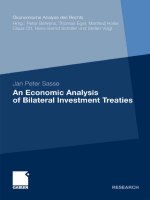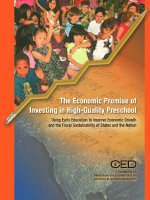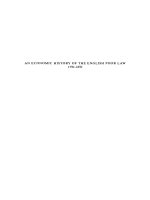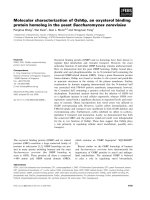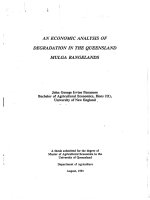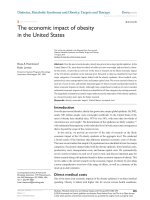AN ECONOMIC ANALYSIS OF DEGRADATION IN THE QUEENSLAND MULGA RANGELANDS pot
Bạn đang xem bản rút gọn của tài liệu. Xem và tải ngay bản đầy đủ của tài liệu tại đây (8.39 MB, 189 trang )
A
thesis submitted for the degree of
Master of
Agricultural
Economics
in
the
University of Queensland
Department
of
Agriculture
August,
1991
iii
Abstract
The
economic issues involved in arid rangeland degradation have become
an
increasing focus
in agricultural economics research world-wide. The economic and social factors which
contribute to degradm'on in Queensland's arid mulga rangelandr are explored in this thesis.
Many
of the region's problems, including the small property size structure, grdng
management practices and land tenure have their origins in the historical development of the
region. These and other factors are idenn3ed using both a regression analysis of cross-
sectional
dm and a stochastic dynamic programming model of the rangeland.
Regressions pelformed on data j?om parallel economic and land condition surveys of
46
graziers in the south-west Queensland mulga rangelandr are used to establish
a
link
between degradation and land utilisation policy. Land degradation is shown to be more
severe on propem'es with higher stocking rates. The importance of property size,
financial
and domestic cost pressures, land condition
and
proportion of residual land types in land use
decisions are explored. De analysis supports the hypotheses that smaller property sizes and
higher interest cost commitments are associated with higher stocking rates.
As
expected,
propem'es with a greater proportion ofpoorer quality land types tend to adopt lower stocking
rates. Kangaroo numbers, an effective regional proxy variable, is positively related to
stocking rates indicating the tendency for native grazer populations to be higher on more
.
productive land types. The regression analysis also provides some evidence that incomes are
higher on properties with a greater degree of
land
degradation.
While the cross-sectional regression approach is emtive in idennning some of the
economic issues,
it
has distinct shortcomings. Regional biases are diflcult to isolate from the
relationships between stocking rates and the various economic factors and much of the
variation in stocking rate may in fact be due to regional
dzrerences. Moreover, the
technique does not adequately consider the intertemporal nature of the rangeland resource
problem.
iv
A
stochastic dynamic programming model, amalgamating the cross-sectional swwy
data with historical field trial data is developed to address these shortcomings.
Ihe
@nmic
programming model describes a Markov decision process, with stocking rate
as
the
sole land
use decision and pasture biomass as the indicator of rangeland condition. For a given
pasture biomass and stocking rate, the transition to a'following stare
is
described
by
a
probability dism'bution derived porn simulated climaric data.
By
individually varying
economic parameters in the model, including property size, wool prices, discount rates and
risk, the response in optimal stocking rates and
returns can be assessed.
The
dynamic
programming model also generates optimal net present values and shadow prices associated
with the marginal usage of pasture biomass corresponding to each optimal decision set.
Pasture condition is imputed from the
long-term probability distribution of pasture stares
generated
by
the model.
_
The dynamic programming model reveals that the small property size structure in the
mulga rangelands, largely a legacy of early land a.inistra.tion policy, is a majorpotential
factor in land degradation. Graziers with small holdingsjind
it
economically optimal to
stock
at
higher rates in an efon to achieve economies offlock size.
The
costs of degradatr'on
incurred by higher stocking strategies are balanced
by
savings porn more encient
management.
l2e
model shows that
at
the average wool prices assumed,
an
area of at least
35,000
hectares is required to produce positive net present values
at
all levels of pasture
biomass.
I
The
effect of wool prices on optimal land use rates reflects the non-linear relationship
between wool quality and price, which makes finer wools relatively more attractive during
periods of high prices. Graziers can gain
by
opportunistically stocking at higher rates to
induce finer wool. The so-called lfine wool effect' can be achieved by felling mulga for
supplementary feed.
The
individual grazier's discount rate is expected to vary according to financial
circumstances, planning horizon and arn'n.de to risk.
Sensitivity analysis of the model
revealed that optimal stocking rates increased
as
the grazier's discount rate rose, reflecting
a decreasing concern for resource conservation. The amtude of graziers to risk is firther
This thesis reports the original work of
the
author, except
as
otherwise stated.
It
has
not
been submitted previously for a degree at
any
university.
analysed in a utility-maximising version of the dynamic programming model. Quadratic,
negative exponential
and
spliced utility Bnctions are used to convert monetary outcomes to
un'lity values. Generally, a more risk-averse
attitude
infers more conservative stocking rates.
Apart from examining the importance of propeny size, wool prices
and
discount rate
in land degradation, the
study
seeks to validate the use of dynamic programming analysis in
policy issues where intertemporal elements are of central importance.
The
problems of
dimensionality,
data
requirements
and
compurational limits which hamper the efectiveness
of dynamic programming
as
a decision-making tool are less resmktive of its usefllness in
examining policy concern. The dynamic programming method
has
firther potential uses in
identBing minimum property sizes for long-tern viability and in the analysis
of
the response
of
land
prices to degradation.
vii
CONTENTS
ABSTRACT
LIST OF TABLES
LIST OF FIGURES
xii
1.
MULGA RANGELAND DEGRADATION
-
AN
INTRODUCTION
1.1.
Defining degradation
1.2.
Degradation of the mulga rangelands
1.2.1.
The degradation cycle
1.2.2.
Extent of mulga rangeland degradation
1.3.
Theory
and analytical issues: A synopsis
e
2.
ECONOMICS
OF
LAND
DEGRADATION
13
A historical perspective
Early grazing management
a;,
Closer settlement policy and property size
A market failure approach to land degradation
Imperfect market for information and research
Divergence between private and social discount
rate
Intergenerational equity issues and market failure
Financial pressures
Ownership intentions and planning horizon
Uncertainty about irreversibility
Property rights and land tenure
Land tenure in the mulga rangelands
.
Land market imperfections
Externalities
Government policy failure
Characteristics of region and production system
Drought management and mulga top-feeding
Native and feral grazing animals
The effect of stocking rate on wool
quality
Summary
C
3.
ANALYSIS OF ECONOMIC FACTORS INFLUENCING
LAND DEGRADATION IN
THE
MULGA RANGELANDS
3
1
3.1.
Hypotheses
3.2.
Survey data
3.2.1.
Survey methods
3.2.2.
Economic data
viii
Land condition
data
Techniques of analysis
The
relationship between stocking rates and degradation
A land degradation variable
Analysis
Economic factors influencing stocking rates
Identification of economic variables
'
Analysis
A two-stage least squares approach
Property incomes and stocking rates
Analysis of land prices and degradation
Land
price analysis for the mulga region
Intra-regional comparison
Inter-regional comparison
C
4.
INTERTEMPORAL OPTIMISATION OF
RESOURCE USE
-
THEORY
AND
APPLICATION
The mulga rangeland resource and its characteristics
A model of renewable resource use
Maximum
sustainable yield
A simple graphical intertemporal model
Dynamic optimisation methods
Optimal control
theory
Dynamic programming
Application of dynamic optimisation methods
Review of dynamic optimisation literature
5.
A STOCHASTIC DYNAMIC PROGRAMMING
MODEL FOR
THE
MULGA RANGELANDS
The model framework
Determination of state variables
Indicators of rangeland productivity
Pasture biomass
Basal
area
Selected state variables and partitions
Determination of decision variables
Selected decision variable
The transition matrix
Methods for deriving the transition matrix
Pasture biomass transition matrix
The stage
return
function
Property sizes
Wool cut per head
Wool quality
Wool price
Stock replacement and values
5.5.5.1.
Mortalities
5.5.5.2.
Normal replacements
5.5.5.3.
Stock adjustment between seasons
5.5.6.
Variable production costs
5.5.7.
Variable marketing costs
5.5.8.
Fixed costs
5.5.9.
Discount rates
5.6.
An
alternative specification
-
A
constrained choice model
C
6.
A
DYNAMIC ANALYSIS OF ECONOMIC
INFLUENCES ON OPTIMAL STOCKING
RATES
Effects of property size
Optimal stocking rates
Optimal net present value function
Shadow prices
Long-run probabilities of
pasture
states
Effects of changing model parameters
Wool
price variations
Wool quality differentials
Discount rates
A
utility maximising model
Constrained choice model
Optimal net present values
and
shadow prices
Sensitivity to property size
and
discount rate
Summary
CH
7.
CONCLUSIONS
7.1.
Economic factors
7.2.
The role of dynamic optimisation techniques
7.3.
Policy issues
.
ACKNO
S
RE
CES
APPENDIX
I
-
APPENDIX
I1
-
APPENDIX
m
-
APPENDIX
IV
-
APPENDIX V
-
APPENDIX
VI
-
APPENDIX
VII
-
APPENDIX
VIII
-
Survey Data Collection Techniques
Pasture Biomass Transition Matrix
Arabella Trial Data
Wool Price Series
Matrix of Stage Return Components
Sheep Mortality Rates
Wool Price Sensitivity Analysis
The GPDP Computer Package
APPENDIX REFERENCES
LIST
OF
TABLES
Table
3.1.
Summary of Economic Data from a Survey of Mulga
Rangeland Graziers, Average per Property.
Table
3.2.
Summary of Land Condition Data from
a
Survey of
Mulga Rangeland Graziers, (per cent of total random points).
Table
3.3.
OLS
Regressions of Land Degradation Variables on Stocking
Rate.
Table
3.4.
Regressions of Economic and Physical Variables on Stocking
Rate.
Table
3.5.
OLS
Regressions of Economic and Physical Variables on
Stocking Rates, excluding Residual Land Types.
Table
3.6.
Land Degradation and Stocking
Rate
-
A
Two-Stage
Least
Squares Approach.
Table
3.7.
Significance of Property Size and Land Condition
in
Explaining Property Incomes.
Table
5.1.
Average Pasture Biomass for Land Classes, 1982 Land
Condition Survey.
Table
5.2.
Pasture Biomass Partitions and Midpoints
Table
5.3.
Stocking
Rate
Decisions and Partitions
Table
5.4.
Pasture Biomass Regressions for Deriving the Transition Matrix,
Double-Log Functional Form.
,
Table
5.5.
Economic Characteristics of Property Size Groups.
Table
5.6.
Wool Cut Per Head for Different Rates of
Pasture Utilisation (Arabella Trial)
Table
5.7.
Average Wool Prices for Fibre Diameter, 1973174 to 1989190,
in
1987188 Dollars.
Table
5.8.
Costs of Mulga Feeding.
Table
5.9.
Average Saleyard Prices for Young and Aged Wethers
at
Dalby
(1987188 Dollars).
Table
5.10.
Penalty Costs for Stock Adjustment over Time.
xi
Table
5.11.
Labour and Materials Costs per DSE,
1987188
Dollars.
Table
5.12.
Variable Production Costs used in Estimating Stage Returns.
Table
5.13.
Wool Marketing Charges.
Table
5.14.
Fixed Costs.
Table
6.1.
Effect of Property Size on Optimal Stocking Rates.
Table
6.2.
Effect of Property Size on Optimal Net Present
Values at Full Equity.
Table
6.3.
Effect of Property Size on Optimal Net Present
Values with Average Interest Costs Included.
Table
6.4.
Effect of
Wool
Prices on Optimal Stocking Rates.
Table
6.5.
Effect of Wool Prices on Net Present Values per
Hectare.
Table
6.6.
Effect of
Wool
Quality Differentials on Optimal
Stocking Rates.
Table
6.7.
Effect of Discount Rates on Optimal Stocking Rates.
Table
6.8.
Optimal Stocking Rates using Quadratic &d Negative
Exponential Utility Functions.
Table
6.9.
Optimal Stocking Rates for a Risk-Averse Grazier at
Four Equity Levels, Spliced Utility Function.
Table
6.10.
Effect of Property Size on Optimal Stocking Rate ~djukrnents.
Table
6.11.
Effect of Discount Rate on Optimal Stocking Rate Adjustments.
xii.
LIST
OF
FI
Figure
1.1.
Location of the Mulga Rangelands
in
South-West Queensland.
4
Figure
1.2.
The Land Degradation Cycle.
1.3.
Number of Paroo River
Flood
Heights over
Three
Metres,
10-year Moving Average, 1926-35 to 1980-89.
.
Annual
Average Rainfall, CharleviUe, 10-year Moving Average,
1926-35 to 1980-89.
Figure
2.1.
Distribution of
Property
Sizes
in
the Mulga rangelands.
Figure
3.1.
Economic
and
Physical Factors
in
the
Land Degradation Cycle.
Figure
3.2.
Actual Land Prices
in
the Eastern and Western Mulga
Rangelands Compared
to
the Prices Paid Index, 1961-89.
Figure
3.3.
Actual Land
Prices
in
the Western Mulga Rangelands and
the Blackall District Compared to the
Prices
Paid Index, 1968-88.
Figure
4.1.
The
Resource Growth
-
Stock Relationship and Maximum
Sustainable Yield.
re
4.2.
The
Intertemporal Optimum for Renewable Resources
-
A Simple Graphical Two-Period Model.
Figure
5.1.
Mulga Rangeland Condition Characteristics.
80
Figure
5.2.
Annual
Wool
Prices
in
Constant 1988 Dollars, by ~ibre Diameter.
95
Figure
6.1.
Shadow Prices for Pasture Biomass. 113
Figure
6.2.
Equilibrium Probability Distribution of Pasture States.
Figure
6.3.
Effect of Wool Prices on Shadow Prices.
Figure
6.4.
Effect of Wool Prices on Equilibrium Probability
Distribution of Pasture Biomass States.
Figure
6.5.
Effect of Wool
Quality
Differentials on Shadow
Prices for Pasture Biomass States.
Figure
6.6.
Effect of Wool
Quality
Differentials on Equilibrium
Probability Distribution of Pasture Biomass States.
.
. .
Xlll
Figure
6.7.
Effect of Discount Rate on Shadow Prices for Pasture
Biomass States.
Figure
6.8.
Effect of Discount Rate on Equilibrium Probability Distribution
of Pasture Biomass States.
126
Figure
6.9.
Net Present
Values
for Pasture and Stocking Rate Combinations,
Constrained Choice Model. 133
Figure
6.10.
Shadow Prices for Combinations of Pasture State
and
Stocking Rate, Constrained Choice Model.
GPDP
Output
RUN LOG: DATE 03-17-1991 TIME 15:35:30
INFINITE STAGE DP PROBLEM
PROBLEM NAME
>
EXP
STOCHASTIC DYNAMIC PROGRAMMING SOLUTION
PROBLEM EXP
PROBLEM PARAMETERS:
INFINITE NO. OF STAGES
RATE OF DISCOUNT (PER CENT)
=
5.0000
FOR FEASIBLE INPUT READ, SOME FOLLOW-ON STATES WITH LOW
PROBABILITIES WERK IGNORED FOR STAGE 0
NUMBER IGNORED:
8
1
LARGEST PROBABILITY:
0
NO. 'OF ITERATIONS TO FIND SOLUTION
=
3
NO. DRYMAT
NO. SR NO. DRYMAT
REQUIRE LONG-RUN
STATE
PROBABILITIES
-
Y(YES)
OR N(N0)
)
Y
NO.
DRYMAT
Appendix References
Australian Wool Corporation, (AWC), (1974 to 1990), Wool Market News. Annual Price
Summaries, Melbourne.
Australian Bureau of Statistics, (ABS), (195 1-52 to 1973-74), Statistics
of
Oueensland,
Brisbane.
Australian Bureau of Statistics, (ABS), (1974-75 to 1988-89), Livestock Stabsbc~
. .
,
Brisbane.
Kennedy, J.O.S. (1989), Manual for GPDP
-
An
Algorithm for General Puroose Dvnamic
Pro~rarnrning,
5th
edition, Latrobe University, Melbourne.
GA
RANGEL
DE
ATION
-
AN
ODUCTION
Degradation of agricultural lands has become a major environmental concern in recent years.
Globally, mankind has degraded more than 430 million hectares of crop and grazing land
(Burch
et
al., 1987).
In
Australia's Pastoral Zone, degradation of arid rangelands which
support about
25
per cent of the nation's livestock is a major problem. (Burch
et
al., 1987)
contend that around 13
per
cent of the 432 million hectares under pastoral occupation has
become severely degraded.
In
Queensland, a 1975 study found that
53
per
cent of the 83
million
hectares
of arid-zone grazing lands showed some evidence of
soil
erosion and
vegetation degradation, with 10
per
cent being severely degraded (Queensland Department
of Environment and Heritage, 1990). This situation was believed to have worsened since that
time.
Despite awareness among land-users and scientists' understanding of
grazing
land
degradation, the problem has persisted.
A plethora of historical, economic, environmental
and institutional factors have
been
identified
as
constraints to land conservation efforts,
including land administration and tenure, property size, debt pressures and market
information problems. These problems have led to a
rate
of land degradation greater than
that which would have naturally occurred before European settlement. Policy makers' usual
solution has been to treat the symptoms rather than the causes (Quiggin, 1987). Taxation
assistance for conservation works is one such example of rnis-directed ameliorative policy
measures (Quiggin,
1987).
The economics of rangeland degradation have attracted little attention in the literature.
This may be due to the low productivity and low value nature of the
arid
rangelands.
As
costs of regeneration and
soil
replacement
are
extremely high relative to land value,
degradation of arid lands is generally irreversible. Treatment of the cause rather than the
symptom is therefore crucial. Economic analysis has a major role in determining the causes
and the appropriate policies to prevent or slow the process of degradation.
The broad objectives of this thesis are:
-
to identify the economic and financial constraints in decisions on' land use
in
Queensland's mulga rangelands;
-
to
examine the impact of changes in3economic conditions on optimal land
utilisation rates over time; and
-
to
explore the potential of dynamic methods in the analysis of policy issues.
1.1. Defining demdation
Degradation has been defined as damage
to
land, water or vegetation resources which
impedes long-term grazing productivity and
ability
to support native animals (Burch
et
al.,
1987; Foran
et
d.,
1990).
The damage
occurs
over a
shorter
time
scale
than
normal
geological processes and is the mult of human intervention (Mills, 1986a).
In
arid
rangelands, degradation describes an irreversible loss of the resource, as distinct from the
temporary effects of extreme
seasonal
variations which charactedsc the system.
In
economic terms, degradation implies a redistribution of resource use rates from the
future to the present with adverse consequences.
The non-Ricardian or destructible
component of the rangeland resource comprises three elements: the conservable flow which
must be kept to ensure future productivity, a revolving fund which
can
economically be
.
replaced by fertilisers, reseeding or other investment, and the initial expendable surplus
which
can
be completely used (Gaffhey, 1965; Van Kooten and Furtan, 1987). Degradation
describes the irreversible deterioration over time of the valuable conservable flow resources,
such
as
topsoil
in
rangelands.
This may occur due to
a
failure of usen to distinguish
between the conservable flow and revolving fund elements.
The evidence of rangeland degradation is a change
in
species dominance from
palatable perennial grasses to woody shrubs, Scalding of soil surfaces
by
wind and water
erosion, and occasional gully erosion. Degradation is believed to be
a
result of
heavy
grazing
and failure to destock during drought, although competition from native grazing
animals and the reduced frequency of natural fire may also play
a
part.
3
Visually, degradation in arid regions removes the uniformity of landscape. Native
pastures become interspersed increasingly with scalded areas, woody weed infestation and
gullying. The visible evidence of economic or management influence is the 'fence-line
effect' along property boundaries.
The
mulga rangelands comprise
some
19 million hectares
in
the south-west corner of
Queensland (Figure 1.1). The rangelands support a significant
pastoral
industry accounting
for about one quarter of
annual
wool production
in
Queensland and one twelfth of the beef
herd
(Mills,
1989). The main shires with mulga rangeland are
Bull00
(30
per cent
of
shire),
Booringa
(30
per
cent), Murweh
(75
per
cent),
Paroo
(65
per cent), Quilpie
(75
per cent) and
Barcoo
(40
per cent) (Reynolds, 1988).
Climatically, the mulga rangelands experience low unreliable rainfall, high
evaporation
rates
and
winter
frosts. Much of the rainfall occurs as isolated heavy falls of
little assistance to plant growth. Between
1880
and 1989, Charleville's
rainfall
averaged
486
rnillimetres. Rainfall was below this average
in
62
of those years, while the lowest recorded
annual rainfall was just
175
rnillimetres (Mills, 1989). Seventy per cent of falls occur
in
the
October to March period (Christie and Hughes, 1983). Drought is
a
dominant feature of the
I
climatic pattern, with some shires being drought-declared for almost half of the past
25
years
(Mills
et
al., 1989; Mills, 1989).
The mulga rangelands comprise two broad land zones, the
soft
mulga and the hard
mulga, distinguished by rainfall, soil and vegetation characteristics. Generally, the hard
mulga lies to the west of Charleville and the Warrego River, stretching west of Quilpie,
while the soft mulga lies to the east.
The
soft mulga zone consists of flat or
gently
undulating plains of red loamy soil supporting
tall
mulga (Acacia aneura) and valuable
perennial grasses.
The hard mulga zone has a lower average rainfall, a more fragile
ecosystem, and is more prone to soil erosion due to shallow soils and low fertility.
Figure
1.1.
Location
of
the Mulga Rangelads in South-West Queensland.
Source:
Mills,
1989
5
These broad zones are interspersed with various other land types.
The mulga
sandplains are flat
areas
of deep sandy soils with mulga shrub cover. Residual lands consist
of the ranges and watershed boundaries with shallow stony soils and have low grazing
potential. Along watercourses, alluvial
plains
and alluvial woodlands support
tall
trees or
shrubs
and
provide the most productive
pastures.
The
gidgee
lands support a dense gidgee
shrub
cover
usually on deep cracking clay soils.
In
the more arid western regions, dunefields
and claypans
occur
with greater frequency.
A
variety of perennial and ephemeral
grasses
form the basis of an extensive grazing
industry. Grazing properties vary in size from under 10,000 hectares to over
200,000
hectares, and typically
cany
4,000
to 12,000 sheep and 100
to
300 head of cattle. The major
source of income is wool, and most properties
carry
a mixture of merino wethers and
breeding ewes. The
poor
breeding capability of the mulga rangelands is reflected
in
low
lambing percentages of 40 to 70 per cent (Sullivan
et
al.,
1986).
Stock losses average
around 7 per cent per annum (Australian Bureau of Statistics, various issues). Cattle provide
a supplementary income on most properties, and if stocked
in
smaU numbers, are believed
to have
little
eifect on overall grazing pressure while absorbing seasonal labour surpluses
(Mills, 1989; Sullivan
et
al.,
1986).
Stocking rates range from 0.2 to 0.5
dry
sheep equivalents
per
hectare @SE/ha).
A
Lands Department survey in 1983 identified an average carrying capat& on
11
Paroo
region
properties of
0.28
sheep
per
hectare (Mills, 1989). Holmes (1986) observed an average
stocking
rate
of
0.47 DSEIha on seven
eastern
mulga properties over the seven years to
1980.
A
later economic survey by Passmore (1990) found an average stocking rate of 0.42
DSEIha in the
eastern
mulga and 0.34 DSE/ha
in
the western region.
1.2.1. The degradation cvcle
Degradation
in
the mulga rangelands is characterised by a change
in
species dominance from
perennial grasses
to
woody weeds and by sheet and gully erosion. Sheet erosion is of most
concern, as the loss of the vital few centimetres of top soil may mean the irreversible loss
of nutrients critical to pasture growth
(Miles
and Baker, 1988). Bare land areas form a
transitional phase
in
the degradation process, and if not revegetated or spelled from grazing,
are susceptible to sheet erosion (Miles, 1990).
The complex cycle of degradation
in
the mulga rangeland is influenced by drought,
the extent of mulga feeding, stock management, native
grazefi
and
fire.
Figure 1.2
compares the degradation cycle with the natural cycle observed under moderate grazing
conditions.
Figure
13.
The Land Degradation Cycle
Source:
Mills,
1989.
The cycle commences with sheet erosion
and
loss
of
ground cover caused by drought
or heavy grazing. Under continued
heavy
grazing,
soil
loss
is
increased and infdtration
lowered. The most palatable grasses are selectively
grazed
resulting
in
a loss of ground cover
and a domination by less desirable
species.
In
the natural state, woody weeds do not
compete well with native grasses and
are
controlled by the natural incidence of fire. With
-
f
reduced grass cover, the rangelands are unable to
carry
a fire. The wider distribution of
native grazing animals and feral animals such
as
pigs and rabbits abets the progress of woody
weed
domination. The degradation cycle is also reinforced by the availability of mulga
as
a
drought reserve feed thereby enabling stocking pressure to be maintained. Mulga removal
breaks the nutrient cycle of replenishment from the living mulga
tree
Wls, 1989).
7
The reduced cover leaves the soil vulnerable to sheet and gully erosion which occurs
as
a result of reduced plant water uptake and greater water runoff.
Sheet erosion
and
the
,-
corresponding loss of nutrients reduces the potential for bare
areas
to be regenerated,
particularly if stocking pressure is maintained. As Miles (3990) states, the relatively infertile
.
soils of the mdga contain around 90 per cent of their vital nutrients
in
the top
3
centimetres
of a 10 centimetre
soil
profile, and
75
per
cent
in
the top
2
centimetres. Using pot trials
Miles (1990) was able to show that a 1 centimetre
soil
loss resulted
in
a
64
per
cent fall
in
plant productivity as
measured
by total plant matter, while a
3
centimetre loss caused an
84
per cent decline.
The cycle of degradation is believed to
occur
in
discrete stages
of
stability or steady
states. The woody weed stage represents one such stable state. Despite the loss of palatable
grasses and a change in species dominance, woody weeds
can
help with
topsoil
retention and
provide litter for the
soil.
The extent of woody weeds is considered a reliable indicator of
land condition (Mills
et
al., 1989). While they indicate the early stages of degradation, a
large infestation is
required
to have
an
effect on total property productivity
(Mills
et
al.,
1989). With careful management, woody weed affected
areas
may still be able to support
perennial
grasses
(Miles,
1990).
A
state of severe erosion with complete loss of the valuable topsoil implies
.
irreversible damage.
If only one tenth of a mulga site is affected by sheet erosion,
productivity (perennial pasture biomass) is likely to
be
halved (MI.LIS
et
al., 1989). With
lower pasture biomass, response to
rainfall
is considerably reduced.
Extent of mulga rangeland de~radation
Potential degradation problems in the mulga rangelands
were
fist noted in
a
survey
by
Skinner and Kelsey in 1964. They reported evidence of sheet erosion and increased run-off
in the western mulga rangelands and concluded that deterioration had occurred during the
previous
20
to
30
years.
The Western Arid Region
Land
Use
Studies
(WARLUS),
undertaken in the 1960s and
1970s by the Queensland Department of Primary Industries, also identified degradation in
the mulga rangelands. These surveys of geology, soils, vegetation and hydrology found that
while most of the
area
was in a productive condition, the early stages of degradation were
evident.
It was left to Mills (1986b), in a land use study of 8.7 million hectares of mulga, to
reveal
the extent of the problem. His study found that 29
per
cent of
the
surveyed
area
showed symptoms of sheet erosion while 20
per
cent had substantial woody
weed
cover.
A
land condition survey of 70 properties in the
western
mulga by Mills
er
al.
(1989)
supported these findings. Properties were rated on a
six-point
scale
from
'very
poor' to
'very good',
based
on woody weed cover, sheet erosion and
quantity
of pasture The results
showed that half of the properties fell into the 'poor'
and
'very poor' categories. Woody
weeds were a problem on 51 properties representing
44
per cent of the total
area,
while
erosion was
severe
on
32
properties representing 9 per cent of the total
area.
The properties
concerned were experiencing substantially reduced productivity.
Miles (1990)
used
the level of radio-active isotope Caesium-137 remaining
in
the soil
from nuclear
tests
of the 1950s to measure the extent of
soil
loss. In Miles' research, the
soil
loss on woody
weed
affected
areas,
bare land and severely eroded areas were each
compared
with
soil
loss from land with a good cover of perennial
grasses
and mulga.
Woody weed affected lands lost
2
centimetres more soil than non-degraded lands over the
30-year period.
The
soil
loss was 2 to 3 centimetres greater on bare land, whereas in
severely eroded areas
a
loss of 5 centimetres of topsoil was recorded for the 30-year
period.
Miles showed that this
soil
was not redeposited but entirely removed from the system.
I
Further symptoms of degradation are reduced infiltration and greater water run-off.
An
increase in the number of flows of the
Paroo
River, the catchment of which lies almost
wholly within the western mulga rangelands, is evidence of greater run-off. This occumed
despite relatively constant rainfall patterns
(Mdes,
1990). Ten-year moving averages of the
number of
annual
Paroo
River flood heights over
3
metres and Charleville rainfall for the
corresponding period are shown in Figures 1.3 and
1.4.


